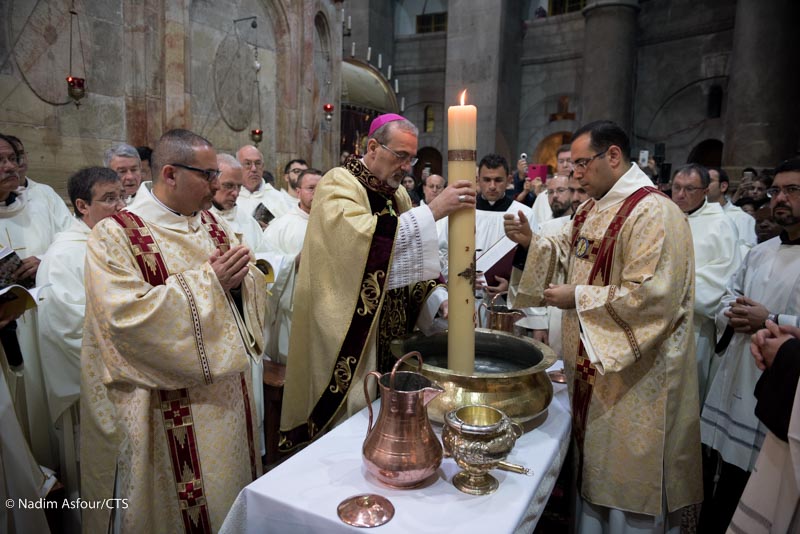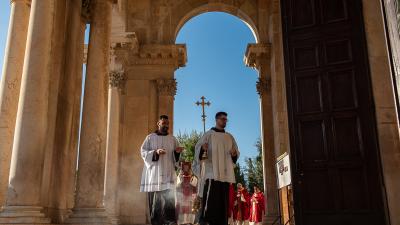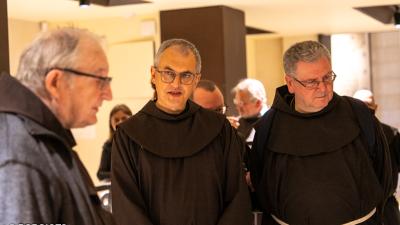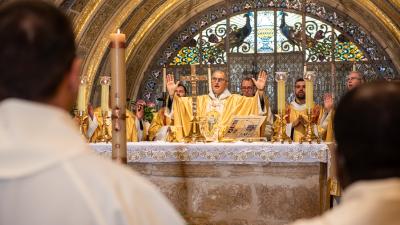
The bells and the organ pierced the silence: Easter was thus announced in Jerusalem. With the anticipation of the Easter vigil on Saturday morning, the Holy Sepulcher was the first place in the world where the Resurrection was announced. At the Holy Sepulcher, the special times of the celebrations were based on the needs of the holy place, where different Christian churches coexist. On Holy Saturday at 7:30 a.m., it was time for the Easter Vigil, and Apostolic Administrator of the Latin Patriarchate, Mons. Pierbattista Pizzaballa, presided over the liturgy. After the short candlelight ceremony—where the faithful’s candles are lit from the Paschal candle—the seven readings from the Old Testament were proclaimed and then two were read from the New Testament. On the occasion of the Gloria, the bells and the organ were played loudly. And all of the emotion of being in the place where Christ rose could be seen in the eyes of many of those present in the form of tears of gratitude. One could perceive so much emotion and disbelief at celebrating Easter in the place where it occurred.
“We have the grace and the responsibility to celebrate the Easter Vigil in the Holy Place par excellence, to touch and witness that which we have just heard in the Gospel is true and we have experienced it,” said Mons. Pizzaballa in his homily. “In this vigil, we celebrate God’s faithfulness to the covenant and his forgiveness,” he continued. “Over the centuries, God does nothing but forgive and reactivate his relationship with man, from Adam, to Abraham to Jesus, who through death and sin brings us back to that full communion once and for all.” The well wishes of Mons. Pizzaballa to the Church was not to close in on oneself and he concluded: “I would like this Easter to make us capable of a way of gazing upon ourselves and our own histories, the gaze of those who have met the Lord and his salvation.”
The following day, on Sunday, the Easter Mass took place in front of the Shrine of the Holy Sepulcher. The Franciscan friars of the Custody of the Holy Land, the priests of the Latin Patriarchate, the general consuls of Belgium, France, Spain and Italy and the Apostolic Nuncio Mons. Leopoldo Girelli were present, as well as faithful and pilgrims from around the world. At the Holy Sepulcher, the communities of the Orthodox churches celebrated Palm Sunday, since according to their liturgical calendar, Easter will fall within one week, and so the chants of the various celebrations often fuse together. This provided a snapshot of the diversity of the Christian Churches of today, which nonetheless share the announcement of the news on which the whole faith is based: Christ is risen. At the end of the celebration, the joy of Easter was proclaimed four times with the reading of the Gospel passages, at four different places, representing the four cardinal points. The Word of God was carried in a solemn procession around the Edicule and the Stone of the Anointment.
In his homily, Pizzaballa said that “Jesus promises life” and “the promise of life, in fact, could only be accomplished if death had been conquered. And there was no other way to overcome the obstacle of death if not by completely going through it, until emerging victorious and opening a passage for everyone. This is my wish for Easter this year: do not be afraid of death,” said Pizzaballa. “This time of ours is marked by death. Life has little value in our parts. One dies easily here. We see it around us, in the countries that surround us and we even see it at home. Easter is entering into these spaces and making it such that those sepulchers, those wounds—in the end—are not mortal to us. Easter is the ability to go back and look at our history in the light of the promise of life that is being fulfilled today.”
Beatrice Guarrera
04/01/2018




